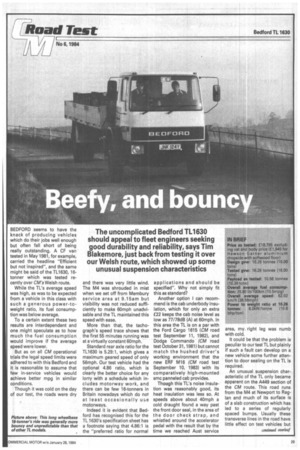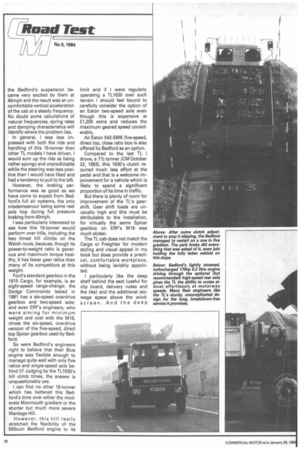Beefy, and bouncy
Page 33

Page 34

Page 35

If you've noticed an error in this article please click here to report it so we can fix it.
The uncomplicated Bedford TL1630 should appeal to fleet engineers seeking good durability and reliability, says Tim Blakemore, just back from testing it over our Welsh route, which showed up some unusual suspension characteristics
BEDFORD seems to have the knack of producing vehicles which do their jobs well enough but often fall short of being really outstanding. A CF van tested in May 1981, for example, carried the headline "Efficient but not inspired", and the same might be said of the TL1630, 16tonner which was tested recently over CM's Welsh route.
While the TL's average speed was high, as was to be expected from a vehicle in this class with such a generous power-toweight ratio, its fuel consumption was below average.
To a certain extent these two results are interdependent and one might speculate as to how much the fuel consumption would improve if the average speed were lower.
But as on all CM operational trials the legal speed limits were adhered to with this Bedford and it is reasonable to assume that few in-service vehicles would achieve better mpg in similar conditions.
Though it was cold on the day of our test, the roads were dry
and there was very little wind. The M4 was shrouded in mist when we set off from Membury service area at 9.1 5am but visibility was not reduced sufficiently to make 60mph unadvisable and the TL maintained this speed with ease.
More than that, the tachograph's speed trace shows that the first 55 minutes running was at a virtually constant 60mph.
Standard rear axle ratio for the TL1630 is 5.29:1, which gives a maximum geared speed of only 56mph. Our test vehicle had the optional 4.86 ratio, which is clearly the better choice for any lorry with a schedule which includes motorway work, and there can be few 16-tonners in Britain nowadays which do not at least occasionally use motorways.
Indeed it is evident that Bedford has recognised this for the TL 1630's specification sheet has a footnote saying that 4.86:1 is the "preferred ratio for normal
applications and should be specified". Why not simply fit this as standard?
Another option I can recommend is the cab underbody insulation, which for only an extra £22 keeps the cab noise level as low as 77/78dB (A) at 60mph. In this area the TL is on a par with the Ford Cargo 1615 (CM road test September 11, 1982), and Dodge Commando (CM road test October 31, 1981) but cannot match the hushed driver's working environment that the new ERF M16 (CM road test September 10, 1983) with its comparatively high-mounted smc panneled cab provides.
Though this TL's noise insulation was reasonably good, its heat insulation was less so. At speeds above about 40mph a cold draught found a way past the front door seal, in the area of the door check strap, and whistled around the accelerator pedal with the result that by the time we reached Aust service area, my. right leg was numb with cold.
It could be that the problem is peculiar to our test TL but plainly if such a fault can develop on a new vehicle some further attention to door sealing on the TL is required.
An unusual suspension characteristic of the TL only became apparent on the A449 section of the CM route. This road runs from the M4 at Newport to Rag lan and much of its surface is
of a slab construction which has led to a series of regularly spaced bumps. Usually these transverse lines in the road have
little effect on test vehicles but the Bedford's suspension became very excited by them at 40mph and the result was an uncomfortable vertical acceleration of the cab at a steady frequency. No doubt some calculations of natural frequencies, spring rates and damping characteristics will identify where the problem lies.
In general, I was less impressed with both the ride and handling of this 16-tonner than other TL models I have driven. I would sum up the ride as being rather spongy and unpredictable while the steering was less positive than I would have liked and had a tendency to pull to the left.
However, the braking performance was as good as we have come to expect from Bedford's full air systems, the only misdemeanour being some rear axle hop during full pressure braking from 40mph.
I was particularly interested to see how this 16-tonner would perform over hills, including the two timed hill climbs on the Welsh route, because, though its power-to-weight ratio is generous and maximum torque healthy, it has fewer gear ratios than many of its competitors at this weight.
Ford's standard gearbox in the 1615 Cargo, for example, is an eight-speed range-change; the Dodge Commando tested in 1981 has a six-speed overdrive gearbox and two-speed axle; and even ERF's engineers, who were aiming for minimum weight and cost with the M16, chose the six-speed, overdrive version of the five-speed, direct top Spicer gearbox used by Bedford.
So were Bedford's engineers right to believe that their Blue engine was flexible enough to manage quite well with only five ratios and single-speed axle behind it? Judging by the TL1630's hill climb times, the answer is unquestionably yes.
I can find no other 16-tonner which has bettered this Bedford's time over either the moderate Monmouth gradient or the shorter but much more severe Wantage Hill.
However, this hill really stretched the flexibility of the 500cuin Bedford engine to its
limit and if I were regularly operating a TL1630 over such terrain I should feel bound to carefully consider the option of an Eaton two-speed axle even though this is expensive at £1,205 extra and reduces the maximum geared speed considerably.
An Eaton 542-SMK five-speed, direct top, close ratio box is also offered by Bedford as an option.
Compared to the last TL I drove, a 71/2 tanner (CM October 22, 1983), this 1630's clutch required much less effort at the pedal and that is a welcome improvement for a vehicle which is likely to spend a significant proportion of its time in traffic.
But there is plenty of room for improvement of the TL's gearshift. Gear shift loads are unusually high and this must be attributable to the installation, for virtually the same Spicer gearbox on ERF's M16 was much slicker.
The TL cab does not match the Cargo or Freighter for modern styling and visual appeal in my book but does provide a practical, comfortable workplace, without being lavishly appointed.
I particularly like the deep shelf behind the seat (useful for clip board, delivery notes and the like) and the additional stowage space above the windscreen. And the deep windscreen, wrap-around rear quarter windows and stoutly mounted good-sized rear view mirrors combine to leave the TL driver with very few blind spots.
But I do not understand why Bedford has chosen to use such a small stirrup step which is mounted so high as to render it almost useless and thus make climbing in and out of the driver's seat unnecessarily awkward.
Summary The TL 1630 has a large capacity, relatively lightly stressed engine, sturdy flitched chassis frame and uncomplicated transmission — all features which are likely to catch the eye of fleet engineers looking for potentially good durability and reliability. The Bedford is not among the most fuel efficient 16-tonners, nor one of the greatest load carriers, but despite its lack of gear ratios it clearly is built for speed and is remarkably adept at hill climbing.
How does the TL1630 compare over the Welsh route with the current best selling 16-tonner in the UK — the Leyland Freighter? While Leyland remains surprisingly coy about releasing a model for road test, it would seem that that question will have to remain unanswered.










































































